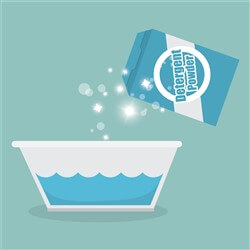June 2024: Cars, Chemicals, & Coverups
In this edition:
- Safe & Sustainable: Powdered or Liquid Laundry Soap?
- Whack-A-Mole or Chemical Management?
- Flame Retardant Usage in Furniture Increases Smoke- Related Casualties
- Decades of Secrets at 3M
- FDA Seeks Comments on Fluorinated Plastic Food Packaging
- Green Science Policy Institute in the News
- Calendar
May was a very busy month with the publication of our study with Duke University finding cancer-causing and neurotoxic flame retardants in all of the 101 cars we studied and a recent staff planning meeting where we prioritized science and policy projects that will contribute most to our mission of reducing toxic harm.
Our vehicle study continues to gain traction. Within a week of our paper’s publication, more than 20,000 people signed the Consumer Reports’ petition urging the National Highway Safety Transportation Administration (NHTSA) to update the unproven 53-year-old
flammability standard that leads to flame retardants inside cars.
The NHTSA standard is followed around the world so hundreds of millions of people are exposed to harmful and unnecessary flame retardants every time they ride in a car. With the help of our new paper, we are happy to be making some progress towards reducing unnecessary flame retardants in cars. Please sign and share this petition if you haven’t done so yet. (Our thanks to everyone who already signed it!)
Underscoring how this standard is problematic for both health and fire safety, renowned toxicologist Linda Birnbaum and veteran firefighter Jay Fleming wrote a persuasive commentary in Environmental Science & Technology. “With improved flammability standards and vehicle design, we can better protect people from both fire and chemical hazards,” they conclude. This expert opinion along with your signatures on the petition will help amplify our science. Happily, NHTSA has confirmed that it is reviewing this issue, and we are continuing to meet with this agency.
Be sure to read the New Yorker and ProPublica bombshell article telling the story of former 3M chemist Kris Hansen. She recounted to journalist Sharon Lerner how the company suppressed her research finding PFAS in nearly all the blood and biological samples she tested and misled the public about the health risks of these chemicals for decades.

I was introduced to Kris two years ago by our former office mate Susan Kegley, who had been her research advisor at Williams College. I was very moved by Kris’s extraordinary story and introduced her to Sharon Lerner, who seemed to me the best person to tell it. Sharon uncovered how Kris had been betrayed by her boss who discounted Kris’s findings of widespread PFAS contamination, knowing all the while she was correct.
Compelling scientific and news articles as discussed above help good science lead to policy change. That’s why communications is a major component of our Institute’s strategy to reduce toxics harm. (Research + Partnership + Communication = Change). You can learn more about the policy, purchasing, and manufacturing changes to which our strategy has contributed by reading our case studies. Please share them further.
For those of you attending the National PFAS Conference in Ann Arbor, MI next week, please join me for a lunch conversation on Monday June 10 and for our workshop “Effective strategies for public communications” on Wednesday, June 12 from 2:30pm-4:30pm.
We wish you a very fun and healthy summer,
Arlene and the Green Science Policy team
Safe & Sustainable: Powdered or Liquid Laundry Soap?
By Marty Mulvilhill, Green Science Policy Advisory Board and Safer Made
When shopping for laundry soap at your local grocery store, consider reaching down to the bottom shelf for a powdered detergent rather than the liquid one at eye level. You may be surprised to learn that powdered detergents and bar soaps are more effective cleaners, gram for gram, than liquids and they require less plastic packaging. They are also safer and more sustainable.
Liquid formulations of detergents, soaps, and cleaning products packaged in plastic bottles first appeared in the 1970s, taking advantage of affordable plastic packaging and chemical preservatives. However, the surfactants, builders, solvents, and chelating agents
needed to make a stable liquid product decrease the efficacy of the cleaning agents.
If you are looking for products with more sustainable packaging and without harmful chemicals, the answer may be sitting on the bottom shelf in the supermarket. Consider switching from liquids to solids, and be wary of detergent sheets which also rely on additional polymers and additives that don't help you clean and may harm the environment.
In summary, powder and solid soaps are a win-win choice: they use less plastic packaging, preservatives, and other chemicals of concern – and they are more effective.
Whack-A-Mole or Chemical Management?
By Anna Soehl
The Six Classes approach was developed a decade ago to help manufacturers and retailers avoid a “chemical whack-a-mole” or cycle of regrettable substitutions where one phased-out harmful chemical is replaced by a similar one that could be even more harmful. To our surprise, the class approach is also being adopted by governments for regulating chemical classes such as PFAS (e.g., European Union, state of Maine), halogenated flame retardants (e.g., US, Europe), and phthalates (e.g., state of Washington).
In an informative recent peer-reviewed paper, scientists from Washington State Departments of Ecology and Health summarize their hazard-based framework for identifying safer alternatives for chemical classes of concern. This approach also includes requirements to determine whether a specific chemical within a chemical class of concern is less hazardous than the class it belongs to.
The authors illustrate how their framework can be used for identifying safer alternatives for phthalates used as plasticizers in vinyl flooring and as fragrances in personal care products.
At the Institute, we are delighted to see how useful the class concept is proving to be for both business and government and how it can improve our health much more quickly than the old one chemical at a time approach by reducing the use of whole classes of harmful chemicals.
Flame Retardant Usage in Furniture Increases Smoke- Related Casualties
By Lydia Jahl
Here in the United States, our furniture is now fire-safe without flame retardant chemicals because our furniture flammability standard was updated in 2014. However, the United Kingdom still has an open-flame standard that is not supported by data and leads to high levels of flame retardants in products.
Importantly, most countries have experienced decreases in fire deaths over recent decades, regardless of flammability standards.
Nonetheless, outdated flammability standards still lead to the use of harmful flame retardants in furniture and other products. Often, a proven fire-safety benefit is lacking, yet the flame retardants increase toxic gas inhalation – the leading cause of fire deaths – as well as everyday exposure to these chemicals.
Researchers at the Centre for Fire and Hazard Science at University of Central Lancashire recently showed how the smoke toxicity of upholstered furniture can be reduced through material changes. Switching to inherently less-flammable furniture fillings, like polyester wadding, or using either no flame retardants or expandable graphite rather than brominated flame retardants, can save lives through decreased smoke toxicity. These findings emphasize the need for fire safety standards to address the risks of smoke toxicity, not just flammability.
Learn more by reading their paper here and a summary blog from our friends at Fidra.
Decades of Secrets at 3M

By Ariana Spentzos
Since the 1970s, 3M has known about the toxicity of PFAS chemicals used in many of their most profitable products, from Scotchgard to firefighting foam. A recently published article from ProPublica and The New Yorker investigates the decades-long corporate
secrets that 3M held, all the while knowing that chemicals from their products were ending up in people around the globe with mounting evidence of myriad toxic effects.
The article, by Sharon Lerner, focuses largely on Kris Hansen, a former 3M employee who was tasked in the 1990s with measuring blood levels of PFOS, a PFAS that 3M manufactured. What follows is an extraordinary story of 3M’s attempts to cast doubt on
Hansen’s scientific findings and obfuscate just how much they knew. 3M kept their knowledge of the harm and the widespread exposure to PFAS secret for many decades as the chemicals contaminated nearly everyone and everything. We highly recommend
this illuminating and sobering read.
FDA Seeks Comments on Fluorinated Plastic Food Packaging
The U.S. Food and Drug Administration has filed a Food Additive Petition submitted by Environmental Defense Fund and others to remove the approval of fluorinated polyethylene as an indirect food additive. The use of fluorinated polyethylene for food packaging and containers can lead to PFAS contamination of food. The production of fluorinated polyethylene also creates PFAS exposure risks for workers and communities near those facilities.
The docket is open for comments until June 25th. Please consider submitting a comment here. Maricel Maffini, [email protected], can answer your questions.
Green Science Policy Institute in the News

Below are recent news articles, blogs, podcasts, newsletters, and more that have featured our Institute’s work and expertise.
● Our car study continued to attract media coverage, including in the Dallas Morning News, Health, New York Post, Consumer Affairs, Science Alert, Driving, CarPro, autoevolution, and the European Union’s official research news website.
● Our report on PFAS in building materials was cited by REMI Network.
● Ariana gave a talk to California Nurses for Environmental Health & Justice about the chemical class approach.
● The Star Press quoted Rebecca about the need for a class-based approach to PFAS in the context of industry efforts to push a limited definition of the class in Indiana.
Calendar
June 12, 2024 at 2:30pm EST:
National PFAS Conference, Ann Arbor, MI.
This workshop will provide inspirational stories and practical guidance to increase the impact of PFAS research and advocacy work through communications strategy. Participants will hear from journalists who cover PFAS as well as from scientists who have successfully communicated their research studies to effect change. For more information: Rebecca Fuoco at [email protected].
October 9, 2024 at noon EST:
NIEHS, Research Triangle Park, NC.
Arlene will present the NIEHS epidemiology branch seminar series talk.
October 11, 2024 at noon EST:
Arlene will speak at Duke University Program in Environmental Health/Superfund
Center seminar series.
Receive Updates By Email
Subscribe to our monthly newsletter and get these updates delivered right to your inbox!




